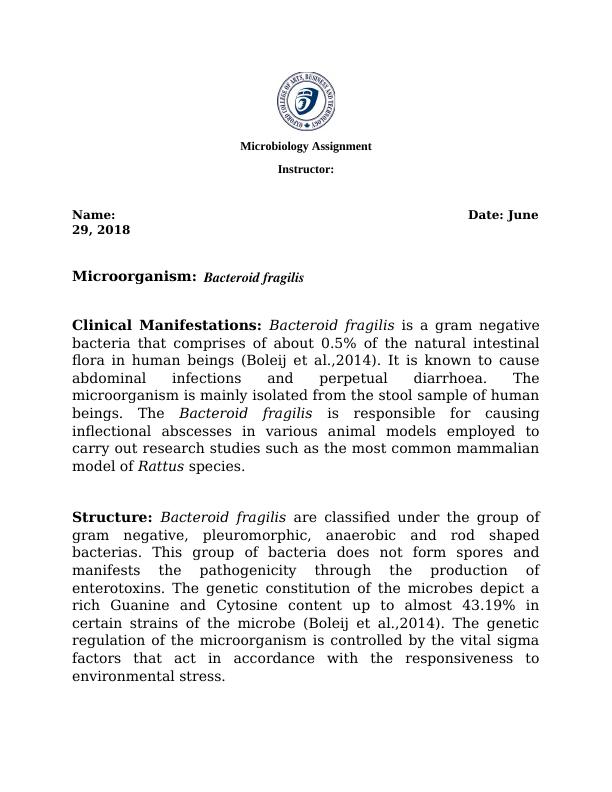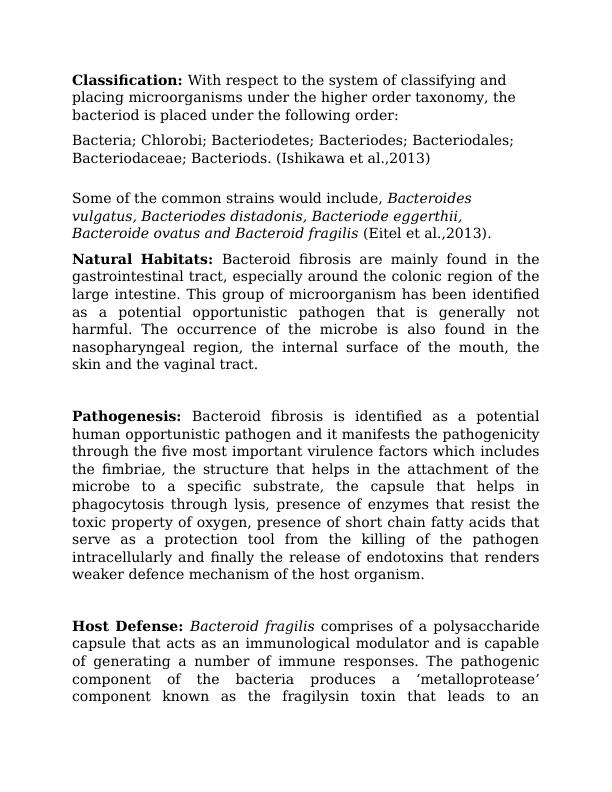Bacteroid fragilis: Clinical Manifestations, Structure, Pathogenesis, Diagnosis, Treatment and Prevention
Added on 2023-06-10
6 Pages1218 Words370 Views

Microbiology Assignment
Instructor:
Name: Date: June
29, 2018
Microorganism:
Clinical Manifestations: Bacteroid fragilis is a gram negative
bacteria that comprises of about 0.5% of the natural intestinal
flora in human beings (Boleij et al.,2014). It is known to cause
abdominal infections and perpetual diarrhoea. The
microorganism is mainly isolated from the stool sample of human
beings. The Bacteroid fragilis is responsible for causing
inflectional abscesses in various animal models employed to
carry out research studies such as the most common mammalian
model of Rattus species.
Structure: Bacteroid fragilis are classified under the group of
gram negative, pleuromorphic, anaerobic and rod shaped
bacterias. This group of bacteria does not form spores and
manifests the pathogenicity through the production of
enterotoxins. The genetic constitution of the microbes depict a
rich Guanine and Cytosine content up to almost 43.19% in
certain strains of the microbe (Boleij et al.,2014). The genetic
regulation of the microorganism is controlled by the vital sigma
factors that act in accordance with the responsiveness to
environmental stress.
Instructor:
Name: Date: June
29, 2018
Microorganism:
Clinical Manifestations: Bacteroid fragilis is a gram negative
bacteria that comprises of about 0.5% of the natural intestinal
flora in human beings (Boleij et al.,2014). It is known to cause
abdominal infections and perpetual diarrhoea. The
microorganism is mainly isolated from the stool sample of human
beings. The Bacteroid fragilis is responsible for causing
inflectional abscesses in various animal models employed to
carry out research studies such as the most common mammalian
model of Rattus species.
Structure: Bacteroid fragilis are classified under the group of
gram negative, pleuromorphic, anaerobic and rod shaped
bacterias. This group of bacteria does not form spores and
manifests the pathogenicity through the production of
enterotoxins. The genetic constitution of the microbes depict a
rich Guanine and Cytosine content up to almost 43.19% in
certain strains of the microbe (Boleij et al.,2014). The genetic
regulation of the microorganism is controlled by the vital sigma
factors that act in accordance with the responsiveness to
environmental stress.

Classification: With respect to the system of classifying and
placing microorganisms under the higher order taxonomy, the
bacteriod is placed under the following order:
Bacteria; Chlorobi; Bacteriodetes; Bacteriodes; Bacteriodales;
Bacteriodaceae; Bacteriods. (Ishikawa et al.,2013)
Some of the common strains would include, Bacteroides
vulgatus, Bacteriodes distadonis, Bacteriode eggerthii,
Bacteroide ovatus and Bacteroid fragilis (Eitel et al.,2013).
Natural Habitats: Bacteroid fibrosis are mainly found in the
gastrointestinal tract, especially around the colonic region of the
large intestine. This group of microorganism has been identified
as a potential opportunistic pathogen that is generally not
harmful. The occurrence of the microbe is also found in the
nasopharyngeal region, the internal surface of the mouth, the
skin and the vaginal tract.
Pathogenesis: Bacteroid fibrosis is identified as a potential
human opportunistic pathogen and it manifests the pathogenicity
through the five most important virulence factors which includes
the fimbriae, the structure that helps in the attachment of the
microbe to a specific substrate, the capsule that helps in
phagocytosis through lysis, presence of enzymes that resist the
toxic property of oxygen, presence of short chain fatty acids that
serve as a protection tool from the killing of the pathogen
intracellularly and finally the release of endotoxins that renders
weaker defence mechanism of the host organism.
Host Defense: Bacteroid fragilis comprises of a polysaccharide
capsule that acts as an immunological modulator and is capable
of generating a number of immune responses. The pathogenic
component of the bacteria produces a ‘metalloprotease’
component known as the fragilysin toxin that leads to an
placing microorganisms under the higher order taxonomy, the
bacteriod is placed under the following order:
Bacteria; Chlorobi; Bacteriodetes; Bacteriodes; Bacteriodales;
Bacteriodaceae; Bacteriods. (Ishikawa et al.,2013)
Some of the common strains would include, Bacteroides
vulgatus, Bacteriodes distadonis, Bacteriode eggerthii,
Bacteroide ovatus and Bacteroid fragilis (Eitel et al.,2013).
Natural Habitats: Bacteroid fibrosis are mainly found in the
gastrointestinal tract, especially around the colonic region of the
large intestine. This group of microorganism has been identified
as a potential opportunistic pathogen that is generally not
harmful. The occurrence of the microbe is also found in the
nasopharyngeal region, the internal surface of the mouth, the
skin and the vaginal tract.
Pathogenesis: Bacteroid fibrosis is identified as a potential
human opportunistic pathogen and it manifests the pathogenicity
through the five most important virulence factors which includes
the fimbriae, the structure that helps in the attachment of the
microbe to a specific substrate, the capsule that helps in
phagocytosis through lysis, presence of enzymes that resist the
toxic property of oxygen, presence of short chain fatty acids that
serve as a protection tool from the killing of the pathogen
intracellularly and finally the release of endotoxins that renders
weaker defence mechanism of the host organism.
Host Defense: Bacteroid fragilis comprises of a polysaccharide
capsule that acts as an immunological modulator and is capable
of generating a number of immune responses. The pathogenic
component of the bacteria produces a ‘metalloprotease’
component known as the fragilysin toxin that leads to an

End of preview
Want to access all the pages? Upload your documents or become a member.
Related Documents
The Biomedical Assessmentlg...
|7
|1976
|23
